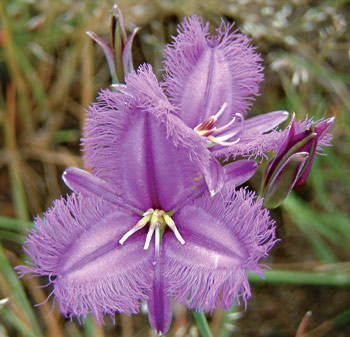
On the Fringe
Julie Lindner
 |
|
Thysanotus tuberosus
Photo: Julie Lindner |
|
To name one's favourite plant is not an easy task - there are so many beautiful plants to choose from. After many days of reflection I settled upon the common fringe lily (Thysanotus tuberosus, family Anthericaceae). Why it is called 'common' I do not know. It might be the most common of the 49 species found (46 in Australia, two in Papua New Guinea and 1 in South East Asia) but how many Australians have ever set eyes on a common fringe lily? One has to be in natural grass or woodlands to see it; its beautiful mauve colour is striking but because of its size it can easily be overlooked or obscured by taller native grasses.
This perennial herb is found in the Australian Capital Territory, New South Wales, Victoria, Queensland and South Australia. Its lily-like flowers up to 30 mm wide have three fringed petals and three narrow petals. Each flower lasts one day, opening early in the morning and usually withering by early afternoon. The flowers occur on branched stems to 80 cm long and each stem can bear up to eight flowers. New flowers are produced over an extended period during early summer, with colours ranging from white to purple. Several tubers 1-2 cm long are produced at the end of the roots - Aborigines ate these crisp tubers that by all accounts are juicy but flavourless.
Generally in the ACT they flower for about a month between mid November and mid December. As with many wildflowers, rain is a critical factor in determining their flowering habits - so if spring is dry not so many are to be found.
I was so intrigued with the first common fringe lily I saw with its delicate iridescent soft mauve fringed petals, I felt it would be more at home in formal surroundings rather than between clumps of Joycea pallida (red anther wallaby grass). I am confident that if it was several times larger it would be up there with the most sought after plants for its beauty. I returned later that day with my camera but searched in vain; I had to wait till the next morning to find another. Ten years on and I cannot walk past a fringe lily without taking a photo - it is a very photogenic plant.
It is really thanks to the common fringe lily that my interest in local plants, and their promotion and preservation, came to the fore.
From the newsletter of the Australian Native Plants Society, Canberra Region, December 2008.
Australian Plants online - 2009
Australian Native Plants Society (Australia)
|